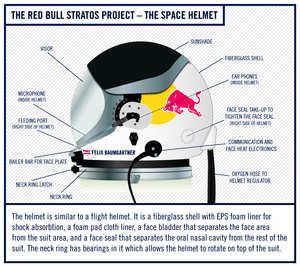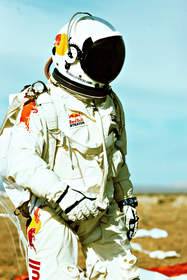SANTA MONICA, CA--(Marketwire - March 30, 2010) - History has been made today as Red Bull Stratos unveiled the first space suit ever to be produced by David Clark Company for a non-governmental space program. The Red Bull Stratos science team has also revealed the pressure helmet, which with the suit will serve as Felix Baumgartner's sole life-support system when he steps off his capsule at 120,000 feet to attempt a record-breaking freefall from the edge of space.
This next-generation gear was manufactured by Massachusetts-based David Clark Company Incorporated, which has pioneered air and space crew protective equipment since 1941, including launch entry suits for Space Shuttle astronauts and the iconic suit that United States Air Force Colonel (Ret.) Joe Kittinger wore on his historic Excelsior III jump in 1960.
Why a Full-Pressure Suit Is Necessary
In the hostile stratospheric environment Felix plans to traverse, hazards include temperatures as cold as minus 56 degrees Celsius; an environment with too little oxygen to sustain human life; and air pressure so low that decompression sickness and ebullism -- a condition in which blood "boils" with life-threatening vapor bubbles -- are pervasive dangers.
During his ascent beneath a 30-million-cubic-foot polyethylene balloon filled with helium, Felix will depend on a sealed capsule to provide a pressurized environment; but once he depressurizes the vessel and opens the door to step off, his full-pressure suit and helmet -- what engineers call a "Pilot Protective Assembly," or PPA -- will be his only life-support system until he reaches the safety of the lower atmosphere.
By attempting to break the speed of sound in freefall, Felix will be trailblazing a velocity that future astronauts and aviators may have to face: although Felix will need to optimize his flight posture to achieve Mach 1, astronauts bailing out from significantly higher altitudes would likely attain supersonic speed involuntarily. Members of the Red Bull Stratos science team expect that the rigidity and protection of a full-pressure suit is necessary to provide benefits at such unprecedented speed, but effectively utilizing the protective assembly will also present challenges.
The Challenges of a Full-Pressure Suit in Freefall
Although a full-pressure suit is essential for survival at high altitudes, such "space" suits have never been qualified for the kind of controlled freefall that Felix Baumgartner must execute to safely return to Earth from the edge of space. The challenges include:
- Restricted mobility: Skydivers are trained to use their bodies to control freefall, making subtle midair positioning adjustments to significantly affect flight. Control is especially critical at high altitude, where rapid spinning is a potentially lethal possibility. The pressurized suit makes some physical adjustments difficult and others impossible.
- Restricted vision: The helmet that protects Felix's head also restricts his vision, a challenge that can be exacerbated if the atmospheric conditions, or perspiration, cause fogging or icing. If Felix can't see, he won't be able to launch the jump.
- Reduced tactile sensation: Felix's hands must be enclosed in pressurized gloves. In his full-pressure suit, Felix will find it more difficult not only to see critical components of his equipment -- like parachute handles or tangled lines -- but also to even feel them.
About the Custom Red Bull Stratos Full-Pressure Suit and Helmet
Thanks to its pioneering work in air and space crew protective equipment design, David Clark Company was able to model the Red Bull Stratos full-pressure suit and helmet on suits already in use by pilots of high-altitude reconnaissance aircraft. However, Felix's PPA was custom made to his measurements and special modifications, including enhanced flexibility, have been incorporated to accommodate freefall demands. Felix's suit will serve as the prototype for next-generation pressure suits.
Mike Todd, the Red Bull Stratos Life Support Engineer, describes Felix's PPA as "an artificial atmosphere." The suit's exterior is made of a material that is both fire-retardant and an insulator against extreme cold. Inside, the "bladder" (which will be filled with gases to provide pressurization before Felix exits the capsule), is composed of a selectively permeable material surrounded by link netting. When the bladder is inflated, it will provide pressure at 3.5 pounds per square inch -- sufficient to prevent the expansion caused by ebullism. An integrated control valve, the "brain" of the suit, maintains pressure automatically at various altitudes.
The shell of the helmet is molded from composite materials. Its visor, which is distortion free in the critical vision area, has an integrated heating circuit that must warm it enough to avert fogging and icing, yet not melt it -- a function doubly challenged by (1) a stratospheric environment that lacks air to draw away heat and (2) a potentially supersonic freefall that will encounter rapid changes in temperature. The helmet will also supply Felix with 100 percent oxygen (from cylinders he'll wear), and it includes a microphone and earphones for communication with the Mission Control Center.
Initial Pressure Suit Findings
"Every time someone jumps a system like this, there's something to learn," says Daniel R. McCarter, Program Manager for David Clark Company. Initial tests conducted in wind tunnels, low-pressure chambers and 25,000-foot skydives indicate that while it's important to assess the pressure suit itself, the key to optimizing its functionality lies in seeing how the suit works with the other mission components, including the parachute rig.
- Low-pressure chamber: The integrity of the personal life support system was confirmed; but, like many astronauts and aviators, Felix found the near sensory deprivation of the suit unsettling and had to accustom himself to a feeling of isolation.
- Wind-tunnel tests: The team was strongly encouraged to learn that when Felix maneuvered to the streamlined "delta" position he will use in his stratospheric freefall, instability minimized and airflow smoothed, despite the unaccustomed bulk of the suit.
- 25,000-foot helicopter jumps: It was found that, due to the suit's sensory limitations, Felix couldn't easily distinguish the handles of his parachutes -- a potentially dangerous situation. The parachute rig has since been modified to make the handles distinguishable by touch even through the pressure suit fabric, and mirrors have been added to Felix's gloves to enable him to see his equipment despite restricted vision in the helmet.
"This is why test jumps are so valuable, because you are always discovering new things," Felix notes. "On the ground, everything looks cool, but the picture changes when you're in freefall. Especially when you're the one in the pressure suit."
About Red Bull Stratos
Red Bull Stratos is a mission to the edge of space. Pilot Felix Baumgartner will ascend to the stratosphere in an attempt to launch a freefall jump that would see him become the first person to break the speed of sound with the human body. The data captured by this mission and its team of world-leading scientists promises new standards in aerospace safety, expanding the boundaries of human flight.
BBC Documentary
An exclusive, all-access documentary about the Red Bull Stratos project is being produced by the BBC together with National Geographic. A few weeks after the jump in 2010, the feature-length film, "SPACE DIVE," will premiere on BBC2 in the UK and National Geographic Channel in the US. It will be aired across the rest of the world soon after. "SPACE DIVE," the 90-minute documentary about Red Bull Stratos, is being globally licensed and distributed to broadcasters by BBC Worldwide.
Red Bull Stratos is proud to share this mission with the following partners:
Nokia
As the official global mobile partner, Nokia has developed the Red Bull Stratos application to monitor this groundbreaking project. Available exclusively through Ovi Store by Nokia, users can learn more about the mission's progress by reading articles and watching videos from the Red Bull Stratos team of experts. Nokia users can also follow the countdown, stream the final jump in real time and watch Felix Baumgartner's pulse race by monitoring his biometrical data before, during and after the jump. Once complete, the app will deliver unique content about the Red Bull Stratos mission direct to handset. For more information, please visit http://www.ovi.com.
Microsoft
Microsoft is the global media technology partner for Red Bull Stratos. Microsoft's Silverlight and IIS Smooth Streaming technology bring an interactive live experience in High Definition to web viewers worldwide. To learn more, visit http://www.microsoft.com/silverlight.
Riedel Communications
Riedel Communications -- renowned for its pioneering advanced fiber, intercom and radio technology -- provides the entire communications solution for this outstanding project, integrating both wireless and wired digital intercom systems. Additionally, Riedel furnishes the fiber-based video and signal distribution as well as the wireless video links to the capsule's onboard cameras -- enabling stunning pictures to be delivered from the Red Bull Stratos capsule. Please visit http://www.riedel.net.
Notes to Editors
About David Clark Company
David Clark Company has pioneered air and space crew protective equipment design, development and infrastructure since 1941, with products ranging from anti-G suits to space suits. David Clark Company's tradition of providing crew protective equipment for leading-edge, manned aerospace programs continues into the future, as their designers apply their expertise to present and foreseeable needs, particularly in the areas of acceleration and high-altitude protection. Additional information can be found at www.davidclark.com.
For hi-res images, B-roll, web videos and additional press materials throughout the project, please visit: www.redbullstratos.com/newsroom.
Red Bull Stratos content, as well as other Red Bull productions, can also be accessed at: www.redbullcontentpool.com.
Contact Information:
Press Information:
Maddy Stephens
Red Bull Communications
210.414.1904
maddy.stephens@us.redbull.com


